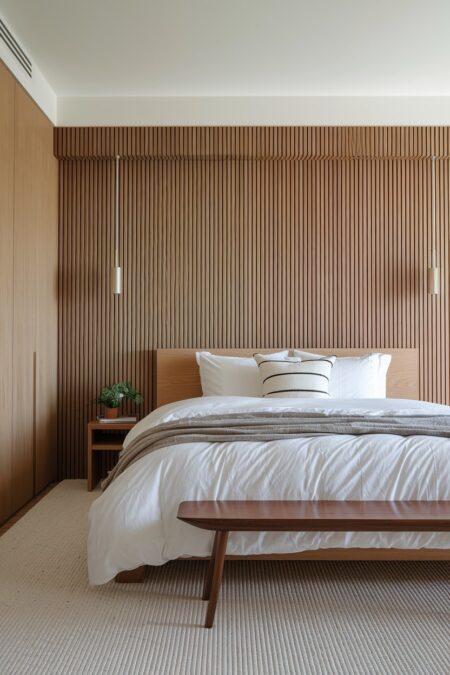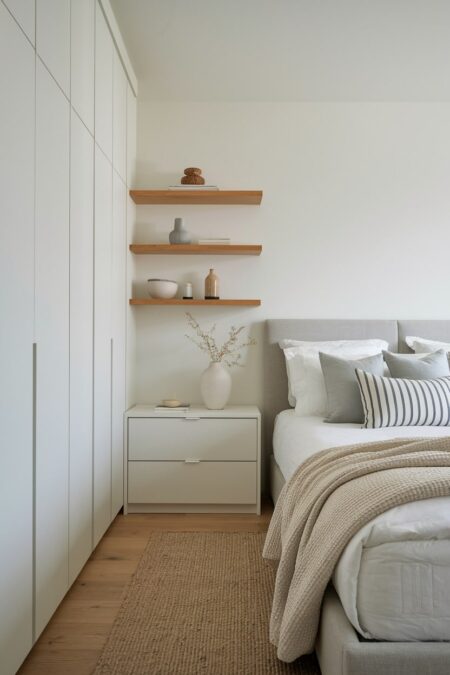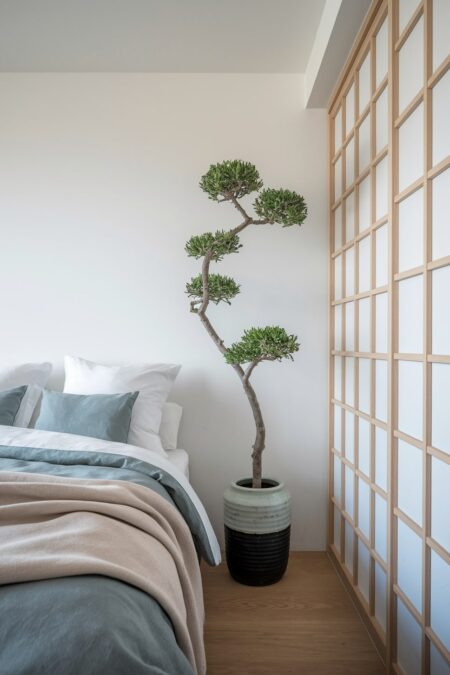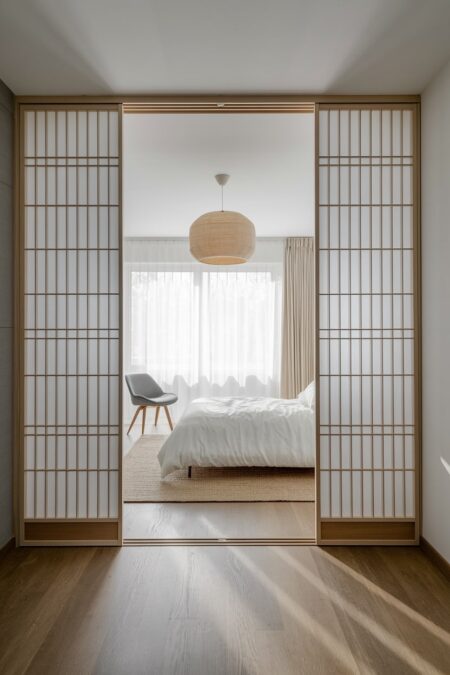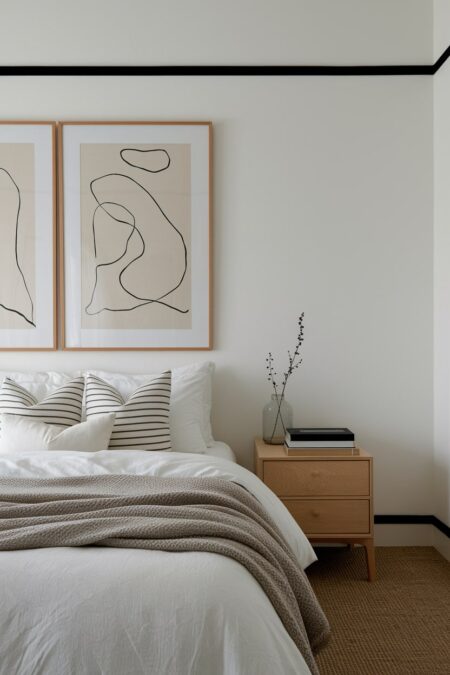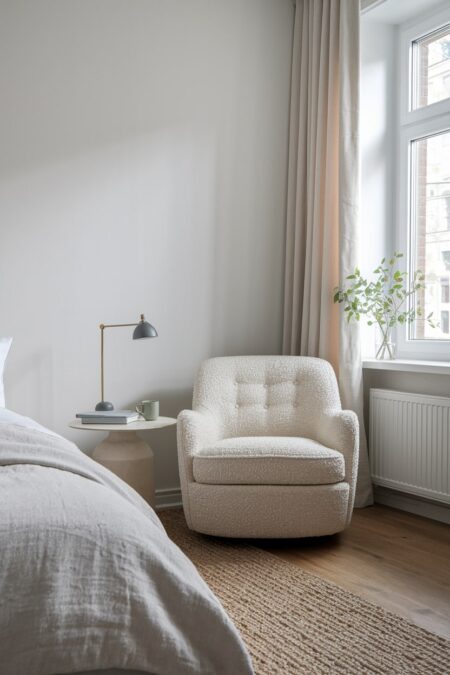The Japandi design philosophy represents a harmonious blend of two distinct cultures, merging the rustic minimalism of Japanese aesthetics with the cozy functionality of Scandinavian design. This hybrid style creates a serene, uncluttered, and deeply personal sanctuary, making it an ideal approach for the bedroom. At its core, Japandi celebrates craftsmanship, natural materials, and the beauty of imperfection. Achieving this look is not about stark emptiness but about curating a space that is both visually calm and warmly inviting. The following ideas explore how to infuse your bedroom with this sense of tranquility and mindful living.
-
01 of 12
Ground the Room with a Low-Profile Bed
A central element in any Japandi bedroom is a bed that sits close to the floor. This practice is borrowed from the Japanese tradition of sleeping on futons on tatami mats, which fosters a sense of being grounded and connected to the earth. Opt for a simple, solid wood platform bed frame in a light oak or a dark walnut finish. The clean lines and lack of ornate detail reinforce the minimalist aspect of the design.
To fully embrace this concept, pair the low frame with simple, high-quality bedding made from natural fibers like linen or organic cotton. Keep the pillows and throws to a minimum, focusing on texture rather than quantity. This approach not only enhances the room’s visual spaciousness but also encourages a more intentional and peaceful state of mind as you begin and end your day.
-
02 of 12
Embrace an Earthy and Muted Color Palette
The Japandi color scheme is drawn directly from nature, creating a calming and restorative atmosphere. Move away from stark whites and instead choose warmer, more complex neutrals. Think shades of oatmeal, stone, beige, mushroom, and soft gray. These colors provide a serene backdrop that allows the textures and materials in the room to take center stage.
For subtle contrast, introduce muted accent colors like dusty rose, sage green, terracotta, or a deep indigo blue. These should be used sparingly, perhaps on a single throw pillow, a ceramic vase, or a piece of abstract art. The goal is to create a cohesive and gentle visual experience that soothes the senses rather than overwhelming them.
RELATED: 14 Earthy Bedroom Ideas to Bring Nature’s Calm into Your Space
-
03 of 12
Incorporate a Mix of Natural Wood Tones
Wood is a foundational material in both Japanese and Scandinavian interiors, but the two traditions often favor different tones. Japandi design beautifully marries the light, airy woods of Scandinavian style (such as oak, ash, and maple) with the richer, more elegant woods found in Japanese homes, like walnut and stained cedar. Don’t be afraid to mix these tones within your bedroom.
A practical way to apply this is by selecting a light oak bed frame and pairing it with darker walnut side tables. Alternatively, you could install a feature wall with light wood slats behind the bed while using darker wood for a bench at its foot. This interplay of light and dark adds depth and sophistication to the minimalist framework.
RELATED: 18 Scandinavian Bedroom Ideas: Simple and Functional
-
04 of 12
Emphasize Rich Textural Contrast
With a simple color palette and minimal decoration, texture becomes crucial for adding warmth and interest. A successful Japandi bedroom engages the sense of touch through a variety of surfaces. Think about layering different materials that feel as good as they look. Combine the roughness of a jute rug with the smoothness of a ceramic lamp base and the softness of a boucle accent chair.
In your bedding, layer a crisp linen duvet cover with a chunky knit wool throw. Consider adding textured wall treatments, such as limewash or clay plaster, to create a subtle, organic backdrop. These tactile details prevent the minimalist space from feeling cold or sterile, infusing it with the cozy comfort of Scandinavian hygge.
-
05 of 12
Choose a Single Statement Pendant Light
Lighting in a Japandi bedroom should be soft, warm, and intentional. Instead of multiple light sources or harsh overhead fixtures, select a single, beautifully crafted pendant light to serve as a functional art piece. Look for fixtures made from natural materials like paper, wood, bamboo, or ceramic. The iconic designs of Isamu Noguchi’s Akari light sculptures are a perfect example of this principle in action.
Hang the pendant low over a corner or beside the bed to create an intimate, focused pool of light. This not only provides gentle illumination but also acts as a sculptural element that draws the eye. Ensure the bulb emits a warm, soft glow to maintain the room’s tranquil and inviting ambiance.
-
06 of 12
Declutter with Purposeful, Integrated Storage
A core tenet of Japandi design is the absence of clutter, which is essential for fostering a calm and clear mind. This requires thoughtful and well-integrated storage solutions. Choose furniture with clean lines and hidden functionality, such as a dresser with handleless drawers or a bed frame with built-in storage underneath.
Consider custom built-in closets with simple, flat-panel doors that blend seamlessly with the walls. The idea is to keep your belongings organized and out of sight, allowing the bedroom to feel open and breathable. Any open shelving should be used with extreme intention, displaying only a few cherished objects that add personal meaning and beauty to the space.
-
07 of 12
Integrate Subtle Biophilic Elements
Bringing nature indoors is fundamental to both Japanese and Scandinavian design. However, in the Japandi style, this is done with restraint. Instead of creating an indoor jungle, opt for a single, well-chosen plant or natural element that makes a quiet statement. A graceful bonsai tree, a tall fiddle leaf fig in a simple ceramic pot, or a single branch with interesting lines placed in a vase can be incredibly impactful.
This approach is inspired by the Japanese art of ikebana, which emphasizes shape, line, and form. The focus is on appreciating the simple, sculptural beauty of the plant itself. This small connection to the natural world enhances the room’s sense of serenity and life.
-
08 of 12
Celebrate the Beauty of Imperfection
The Japanese concept of wabi-sabi is the appreciation of beauty in things that are imperfect, impermanent, and incomplete. Introduce this idea into your bedroom by choosing items that show the hand of the maker. This could be a slightly asymmetrical hand-thrown ceramic vase, a rough-hewn wooden bench, or bedding made from naturally wrinkled linen.
Avoid items that are overly mass-produced or perfectly symmetrical. These small imperfections add soul and character to the room, telling a story of craftsmanship and authenticity. They serve as a reminder that true beauty is often found in the unique and the natural, not in flawless perfection.
-
09 of 12
Use Shoji-Inspired Room Dividers
Traditional Japanese homes often use shoji screens — translucent paper panels in a wooden lattice — to divide spaces and diffuse light. You can incorporate this element into your bedroom to add architectural interest and functionality. Use a freestanding shoji-style screen to create a small dressing area or to shield a workspace from the sleeping area.
For a more permanent solution, consider installing closet doors with frosted glass or linen panels set into a simple wooden frame. These screens provide privacy while allowing soft, natural light to filter through, maintaining the bright and airy feel that is characteristic of Scandinavian design.
-
10 of 12
Select Minimalist, Nature-Inspired Artwork
Art in a Japandi bedroom should be chosen with care and should complement the room’s serene atmosphere rather than dominate it. Select one or two large pieces of minimalist art with simple forms and a connection to nature. Abstract paintings with organic shapes, simple line drawings, or traditional ink wash landscapes are all excellent choices.
Frame the artwork in a simple, natural wood or thin black metal frame. The placement is just as important as the art itself. Hang it off-center or in an unexpected place to create a sense of balance and intrigue. The goal is to evoke a feeling of calm and contemplation, not to create a busy gallery wall.
-
11 of 12
Carve Out a Serene Reading Nook
Create a small, dedicated space for quiet reflection, reading, or enjoying a cup of tea. This aligns with the Scandinavian value of carving out intentional moments for comfort and well-being. All you need is a comfortable yet structurally simple armchair, perhaps in a textured fabric like linen or boucle, and a small side table.
Place this nook near a window to take advantage of natural light. The side table should be just large enough for a book and a cup. This small, curated corner provides a functional purpose while reinforcing the bedroom’s role as a personal retreat from the stresses of the outside world.
-
12 of 12
Layer Rugs Made from Natural Fibers
To complete the sense of warmth and comfort, ground your Japandi bedroom with soft, natural-fiber rugs. A large area rug made of jute, sisal, or wool can define the sleeping area and add a significant layer of texture to the room. Choose a rug in a solid, neutral color or one with a very subtle, simple pattern.
For added depth and a touch of hygge, consider layering a smaller, softer rug, like a sheepskin or a plush wool shag, on top of the larger base rug. This technique adds visual interest and a luxurious tactile experience underfoot, perfectly balancing the room’s minimalist aesthetic with a feeling of cozy indulgence.



